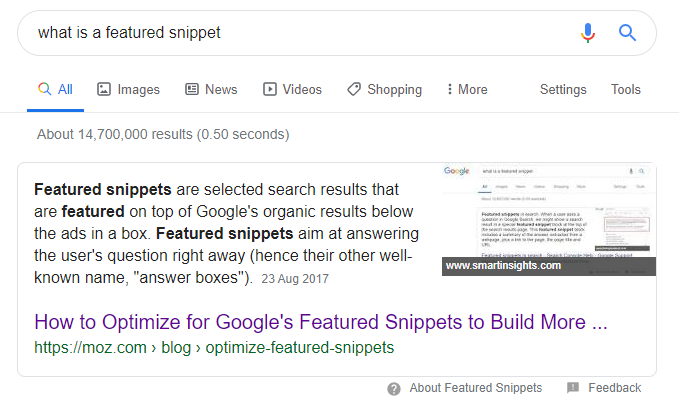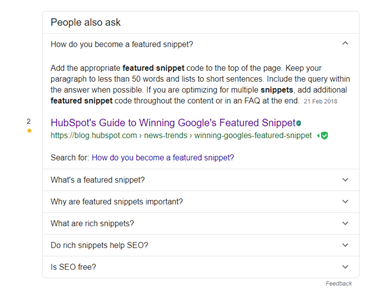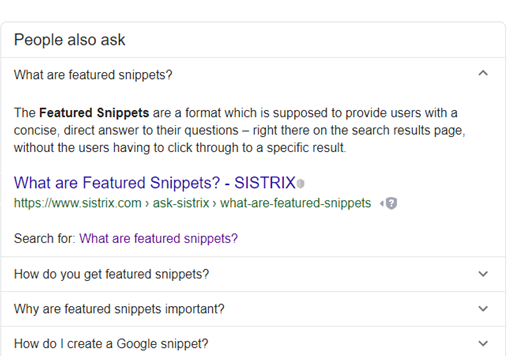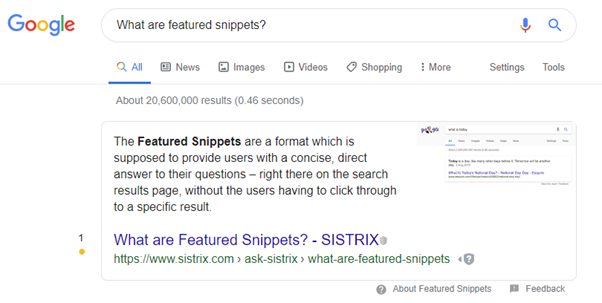Getting those elusive featured snippets in the Google SERPs is a goal for most SEOs – particularly those working on the content side of things.
Featured snippets are the small sections of text enclosed in a box that appear at the top of some search results pages (see below). They are very valuable as they a) can increase CTR through to your site and b) take up more space at the top of the search results page, pushing your competitors further down.

Another common SERP feature that is very closely related to featured snippets is “People Also Ask” (PAA), also referred to as “related questions”. This can appear in different locations on the results page, but is often found just below a featured snippet or the first few results. Questions appear in an expandable list as below, with more questions automatically loading as you click on different questions.

PAA has been appearing in more and more searches over the past couple of years and is now (October 2019) featuring in 90% of SERPs, according to Moz. This means there is much more opportunity to achieve a SERP feature higher up on the page and attract more clicks. Here at Kumo, around March 2019, we suddenly started noticing a huge upturn in traffic for existing blog posts and found this to be a result of them starting to appear in the PAA section.
It’s not 100% clear how “People Also Ask” and featured snippets are related, but there’s no doubt that they are. The PAA answers tend to also be featured snippets for those respective search queries, as can be seen if you click through:
“People also ask”:

After clicking through to “What are featured snippets” under “People Also Ask”:

For this reason, the same principles apply in achieving both featured snippets and PAA questions. While this post will focus more on what and how to write for featured snippets, it’s worth noting that you can also markup your content to make it more likely to become a featured snippet. This won’t guarantee you a featured snippet by any means, and it is not a requirement, but it can help.
This article from Reboot explains the different meta tags you can use to help determine whether a featured snippet appears for a page, as well as its length. In addition to paragraph text, featured snippets can also appear in the form of lists or tables, so bear this in mind and code up your content appropriately if you think a list or table could work well in response to your target search query. You can also add schema to things like recipes to help Google understand and pull out relevant content.
So, how do you go about writing the actual content that will get you some featured snippets and PAA answers?
1. Answer the right questions
Search has always been about giving people answers, but the increasing prevalence of featured snippets and PAA indicates a move towards giving people quick, concise answers to specific questions. This likely reflects the fact that around 60% of searches are now carried out on mobile: when using mobile devices, people tend to be looking for quick answers. And on a mobile phone, a featured snippet usually fills up all or most of the screen, making obtaining one all the more valuable.
The first thing to do is look at what featured snippets and related questions already exist around the topic you are writing about. You can also see what featured snippets your competitors already have using SEMrush. If any of the answers you find seem like they are lacking and could be answered better, these could be good ones to target first.
Also, don’t limit yourself to the questions you already see in the SERPs – Google is adding new featured snippets all the time! Maybe there are other questions out there that no one has given a good answer to yet. Use tools such as Answer the Public, talk to people within your business and find out what questions might be pertinent to your customer base.
2. Be concise – but don’t skimp on the detail
The key to gaining a featured snippet is toeing the line between writing content that is comprehensive enough to rank well and creating clear, concise answers to search queries.
Featured snippets are always taken from pages that are ranking on page one, so the content on your page needs to be good quality and provide value to search users so that you rank well. However, it also needs to include self-contained, concise answers to questions, which Google can identify and pull for snippets and PAA.
One way to achieve this is by creating one long piece of text that answers multiple questions. Have a list of questions you want the text to answer and use clear < h2 > subheadings to separate the different sections. You can even use the questions themselves as subheadings, if appropriate.
Alternatively, you could give a simple, concise introduction that could be used as a featured snippet and take a deeper dive into the topic in the rest of the content. This works better for complex topics that require a dedicated post or article with an in-depth explanation.
Either way, structure is key. Make sure you have clear sections and markup your text properly with < p > and < h > tags, as well as proper markup for lists and tables where appropriate.
In terms of overall word count, there’s no hard and fast rule. Looking at content for one of Kumo’s clients, Willshee’s, that has achieved featured snippets, there is a big variation. For example, there is an article on disposing of garden waste in a skip of 540 words, another on landlords’ waste responsibilities with 750 words, and an interactive recycling map with accompanying text that was 2877 words. You’re just aiming to make the best resource possible for answering the search query (or queries!). All of these pages saw a significant upturn in traffic once they had won a featured snippet.
3. Keep your language simple
Content that ends up in featured snippets is simple, clear and easy to understand. Almost everyone uses search engines, but not everyone is an expert in their chosen topic or able to understand complex syntax and jargon.
If you want to check the readability of your text, there are online readability tools that will analyse what you’ve written and provide feedback, such as the readability test tool from WebFX.
If you’re including a list or set of instructions, make sure they are also clear and easy to follow.
Featured snippets and People Also Ask answers can be great for obtaining traffic for your website and should definitely be taken into account as part of your SEO content strategy. However, remember that they are only one element of the inbound content marketing mix – your overall focus should always be on a constant supply of fresh, relevant and quality content for your audience, in whatever form that may take.
Author Biography
Rachel
Rachel has been working at Kumo since the start of 2018 and is a Search Engine Marketer and Head of Content. She makes sure all Kumo's clients always have fresh, engaging content that helps their websites rank and attract links.
She is also fluent in German, which comes in handy for any German websites that need content and SEO work!